2. "You Always Have to Slug 'em"
What are Crime Comic Books?
"And children grow up where the shadows falling
From wall and window have the light exiled,
And know not that without the flowers are calling
Unto a day of distance, wind and wild."
- Rainer Maria Wilke
"Every boy has his idol! He may be a star athlete, a two-fisted Hollywood
Western actor or a famous general. But some boys veer away from such heroes,
and admire the bad men."
This is the beginning of a comic-book story in which a 'hood' teaches two little
boys: "If you kids wanna learn to be like me, you gotta be tough! Never give
the other guy an even break!" He shows them a well-dressed young boy. They
proceed to threaten this boy and he hands over his money to them. But that does
not satisfy the tough teacher. He bangs their heads together and exclaims: "You
always have to slug 'em! Remember that!" This is the elementary lesson of
crime comics.
Many adults think that they know all about crime comic books because they know mystery and detective novels, comic strips in newspapers and have cast an occasional glance at a comic book at a newsstand or in a child's hands. But the Lafargue group of researchers has often convinced itself that most adults have really no idea of the details and content of the majority of crime comic books. I have heard public discussions where only the publishers and their representatives knew what was being talked about; the parents, teachers and doctors who asked discussion questions spoke of comic books as if they were fairy tales or stories of folklore. Children, however, do know what comic books are. The whole crime comic book trade is designed for them and is dependent on them, even though there are adults, too, who read such comics.
For years we have been testing this in many ways, including interviews with people who sell comic books
in big and little newsstands in cities and towns, in big drugstores and little candy stores, in general stores
and ice-cream parlors. Our studies included several states and did not overlook the smallest villages in the
country. We have found crime comic books shown in display cases side by side with - and mingled with -
comic books not featuring crime, intended for the very youngest children. And in many non-crime comic
books we have found alluring advertisements drawing the child's attention to crime comics. The wording
of advertisements for toys in many of the worst crime comics make it apparent that the books carrying
these advertisements are intended for children, and some of the most irresponsible crime comic books
have approving letters from child readers.
Of course there are people who still fall for the contention of the comic-book
industry that their products deal not with crime, but with the punishment of crime.
Is not the very title of some of these books, Crime Does Not Pay?
Here, too, adults are more readily deceived than children. Children know that in
quite a number of crime comic books there is in the title some reference to
punishment. But they also know that just as that very reference is in small letters
and inconspicuous color, the parts of the title that really count are in huge, eyecatching type and clear sharp colors:
CRIME; CRIMINALS; MURDER; LAW BREAKERS; GUNS; etc.
The result of this is, of course, that when comic books are on display only the crime and not the punishment is visible. Often the type of the second part of the title is so arranged that in the display case it does not show at all, concealed as it is behind the tops of other comic books. These are a few examples:
LAWBREAKERS Always Lose
There Is No Escape For PUBLIC ENEMIES
The West Thunders with the Roar of GUNS
CRIME Can't Win
Western OUTLAWS and Sheriffs
CRIMINALS on the Run
The great attraction of crime comic books for children is alleged to be continuous fast action. There may be some. But when the stories come to details of a delinquency or depiction of brutality, the action slows noticeably. A typical example, vintage autumn, 1950: In one story there are thirty-seven pictures, of which twelve (that is, one in three) show brutal near rape scenes. The story begins like this:
"Late one night, in the suburbs of a large city, the moon looks down on the
figure of a lone girl as she walks along a block of slumbering homes....
Anything can happen at this hour!"
Forthwith it does. For example: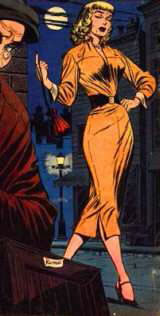
1) The girl walking along with a dark figure, his arm stretched out toward her,
lurking behind.
2) The girl falling over, her breast prominent, her skirt thrown up to reveal
black net panties, the "attacker" a black, shadowed figure leaning over her.
3) He "drags her into the gloom," holding his hand over her mouth and tearing off her coat.
4) He has her on the ground behind some bushes.
5) A girl, murdered, and presumably raped, is shown on the ground with her clothes disordered and torn.
6) Another girl being choked from behind. Screams: "AI - EEEK!!"
7) "The Strangler" locks her in a warehouse, saying: "I"ll kill you just like I did the others - Then I'll crawl
down the trap door and get away under the dock - HA! HA!"
When Mr. E.D. Fulton, member of the Canadian House of Commons, introduced his anti- crime- comicbook
bill before that House, he characterized them as "the kind of magazine, forty or fifty pages of which
portray nothing but scenes illustrating the commission of crimes of violence with every kind of horror that
the mind of man can conceive."
In our clinical research on crime comic books we came to the conclusion that crime comic books are comic books that depict crime, whether the setting is urban, Western, science-fiction, jungle, adventure or the realm of supermen, "horror" or supernatural beings. We found that to study the effect of comic books on children it is necessary to study the comic books themselves, too. To read them like an adult is not enough. One must read them in the light of how children read them. The comic book as a whole has a number of features which children single out habitually and which reinforce one another.
First of all there is the cover. It is always printed on much better paper than the rest of the book, and of course has much larger print and the colors stand out more glaringly and forcefully. The title also counts for a lot. The scene depicted on the cover is usually violent. It is intended to catch the child's attention and whet his appetite.
For example, in a comic-book reprint of a newspaper comic strip - the cover
shows a scene which does not occur at all in the strip. In transforming this
comic strip, intended chiefly for adults, to a comic book for children, this scene
is added: A young woman with prominent breasts and nude legs is lying on a
cot. Her lips are rouged, her hair falls loosely in masses over her bare shoulders
and her face has a coquettish expression.
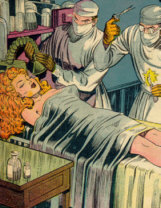 This is supposed to be the scene of a surgical operation! There are two whitegowned
and white-capped men beside her, one about to put a chloroform mask
over her face, the other holding scissors in his right hand and in his left a knife
whose sharp blade is surrounded with a yellow zigzag halo (used in comic
books as a rule to designate the effects of cutting or shooting). The whole scene
This is supposed to be the scene of a surgical operation! There are two whitegowned
and white-capped men beside her, one about to put a chloroform mask
over her face, the other holding scissors in his right hand and in his left a knife
whose sharp blade is surrounded with a yellow zigzag halo (used in comic
books as a rule to designate the effects of cutting or shooting). The whole scene
has nothing to do with medicine and is unmistakably sadistic.
The covers often have little encircled messages. Conspicuous ones may indicate that the stories are based
on true police cases or F.B.I. files. Inconspicuous ones may bear heartwarming words to the effect that the
law will prevail eventually. Other messages on the cover are like seals. They may indicate that the comic
book conforms or professes to conform to some special code, or very similar signs may indicate just the
firm or the publisher.
A typical sample has inconspicuously above its crime title, "A force for good in the community!" and underneath that in a small circle, "Crime does not pay," and then in a square, "TRUE criminal case histories!" and, in smaller type, hard to read, the words "Dedicated to the eradication of crime!" Average, normal boys have often told me that if they read such signs at all they know of course that they are only"eyewash" intended to influence parents and teachers who have no time to read the whole comic book.
The cover of this sample depicts a corpse with blood on his mouth, with the killer who has just beaten him to death beside him.
Another important feature of a crime comic book is the first page of the first story, which often gives the child the clue to the thrill of violence that is to be its chief attraction. This is a psychological fact that all sorts of children have pointed out to me.
Macbeth in comic book form is an example. On the first page the statement is
made: "Amazing as the tale may seem, the author gathered it from true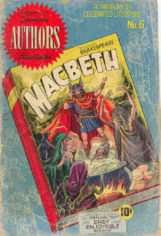
accounts" - the typical crime comic book formula, of course. The first balloon
has the words spoken by a young woman (Lady Macbeth): "Smear the sleeping
servants with BLOOD!"
To the child who looks at the first page "to see what's in it," this gives the
strongest suggestion. And it gives the whole comic book the appeal of a crime
comic book. As for the content of this Macbeth, John Mason Brown, the wellknown
critic, expressed it in the Saturday Review of Literature: "To rob a
supreme dramatist of the form at which he excelled is mayhem plus murder in
the first degree... although the tale is murderous and gory, it never rises beyond
cheap horror... What is left is not a tragedy. It is trashcan stuff." It is interesting
that what adult critics deduce from the whole book, children sense from the first balloon. They know a
crime comic when they see one, whatever the disguise.
The educational page, skipped by many children, pointed with pride by the publishers and approved (but not sufficiently scrutinized) by parents and teachers, could conceivably contain a counterstimulant to the violence of the stories, but often it just gives some historical rationalization of it.
In a jungle comic book what does the educational page show? This one is entitled "The First Americans."
A young girl in modern evening dress, her wrists chained to a tall upholstered structure so that she leans
backward in a recumbent position revealing the full length of her legs, with a definite erotic suggestion, is
being menaced with a big knife held by a gruesome masked figure: "At harvest and planting time they
would cut out the heart of a living victim." In other words, the education to sadism permeating this whole
book is here fortified in the guise of history.
Other features in the structure of a crime comic book are the first  page of or
page of or
before each individual story, the content of the stories, the type of language used,
recurring details of plot or drawing as opposed to the professed ideology, the
advertisements and the endorsements in the form of names of endorsers and the
prominent institutions with which they are connected.
Endorsements came into fashion after Sterling North, the literary critic, early in the forties, published a
number of critical articles based on his reading of comic books. As one boy told me when I asked him
what these endorsements by psychiatrists and educators meant to him, "Oh, the more endorsements they
need, the more they have." The claim that crime comic books might instill in any adolescent or preadolescent
of average intelligence the idea or sentiment that prevention of crime or of antisocial activity is
their goal, is so farfetched that mere reading of the comic books in question will answer it.
Take a comic book with a characteristic crime title, a lurid cover with a picture of one gangster about to be murdered by some other gangsters, and an inconspicuous circle with a purple passage of ethical makebelieve:
"This magazine is dedicated to the prevention of crime. We hope that within its pages the youth of America will learn to know crime for what it really is: a sad, black, dead end road of fools and tears."
Compare with this sentiment some of the highlights inside this cover:
1) A criminal terrorizes a family on a farm, makes advances to the farmer's young wife and beats the
farmer when he objects.
2) He takes the little boy into the woods as a hostage.
3) The little boy, after a while, says: I can't go any faster an' I don't care! You're gonna kill me anyhow!" -
to which the criminal replies: "Ya wise little rat! I'll kill ya! But before I do Ill knock yer teeth out!!"
4) The little boy, as he is being beaten, "OH-H-H-H-H-H H..."
5) In the end, the criminal, who of course commits many other crimes in the course of the story, is not
punished by the law, but like a hero refuses to give himself up, and shoots himself.
This story has ninety-seven pictures where the criminal is winning and one for the apotheosis of his
suicide. Of course there is a gun advertisement, too. If the child who read the purple passage on the cover -
if he did read it - reads the book this far, he knows that this passage has nothing whatsoever to do with the
contents of the comic book.
A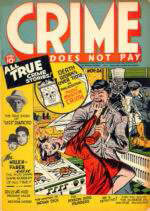 s far as literate adults were concerned, this type of children's literature got into
mass circulation unnoticed. A best seller for adults which is distributed in 10,000
copies or so is discussed in learned book reviews for its art, its technique, its plot,
its social significance. A crime comic book is printed in from 250,000 to 500,000
or more copies, and most copies are read by several children, and exchanged,
s far as literate adults were concerned, this type of children's literature got into
mass circulation unnoticed. A best seller for adults which is distributed in 10,000
copies or so is discussed in learned book reviews for its art, its technique, its plot,
its social significance. A crime comic book is printed in from 250,000 to 500,000
or more copies, and most copies are read by several children, and exchanged,
sold, retraded. However, these books are not reviewed or taken notice of.
It has been said by experts of the industry that children have to learn about the
life around them, and that for this comic books are a big help. Do children really
have to learn this sort of thing, and in this way? Here is a comic book whose
cover bears the slogan: "Every word true!" Inside is an orgy of brutality, crime,
"dope selling," men tortured, girls with half-bared bosoms, pictures of men
stabbed in the stomach, shot, their arms twisted and, of course, an advertisement with a half page picture
of a gun.
Many adults think that the crimes described in comic books are so far removed from the child's life that
for children they are merely something imaginative or fantastic. But we have found this to be a great error.
Comic books and life are connected. A bank robbery is easily translated into the rifling of a candy store.
Delinquencies formerly restricted to adults are increasingly committed by young people and children.
The comic-book stories about drug addiction are an instructive angle. The lead story of one crime comic,
for instance, deals with narcotics. It is clear from the wording of the advertisements that the book is
intended for children: "Dad and Mom will want it too." Traffic in narcotics is described and the high
profits alluringly pointed out. Another crime comic describes the wonderful effects of morphine: "One
needleful of joy-juice and you get so satisfied with the world you forget your obligations!"
When I criticized these morphine and heroin comics stories for children I came up against the objection
that in reality children have nothing to do with drug addiction, so this meant nothing to them. That was
several years before newspapers and news magazines had headlines like "New York Wakes Up to Find
1500 Teen-Age Dope Addicts."
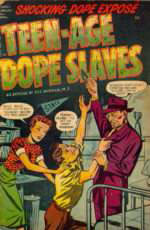 We had known about childhood drug addiction for some time. It was one of the
Lafargue child-guidance counsellors who brought the first child drug addict to
We had known about childhood drug addiction for some time. It was one of the
Lafargue child-guidance counsellors who brought the first child drug addict to
official attention. This boy of fourteen had come and asked for help. "I am a
mainliner," he said. "I want to get rid of the habit. I have been popping myself. I
have been hitting the mainline." He rolled up his sleeves and showed the sores on
his arm. He had a needle with a plain eyedropper attached with which he had
given himself injections. A regular hypodermic needle was too expensive for him.
He had been stealing to buy the narcotics.
The facts are that there are heroin addicts who are only twelve years old, that
peddlers have been giving school children free samples, that fourteen-year-old
boys have been selling heroin on the street, that eight-year-old children have been
used by adults as messengers in the drug racket, that a seventeen-year-old girl
earned $1,000 a week through the sale of narcotics, and that many children under thirteen have been
introduced to heroin. It was found that in certain sections almost two thirds of the high school seniors had
been offered narcotics.
All child drug addicts, and all children drawn into the narcotics traffic as messengers, with whom we have
had contact, were inveterate comic-book readers. In the lives of some of these children who are
overwhelmed by temptation the pattern is one of stealing, gangs, addiction, comic books and violence.
The parallel with crime comic stories is striking. When one knows the social milieu of some of these
children one realizes that the spirit that permits crime comic books to exist and flourish is what permits the
possibility of childhood drug addiction. And whatever factors come into play in the cases that we have
studied, the conclusion is inescapable that crime comics do their part in the education of these children, in
softening them up for the temptation of taking drugs and letting themselves be drawn into participation in
the illegal drug traffic.
In the light of these facts it is indicative of the general misconception about crime comics, and a matter of
regret, that a public agency like New York City's Youth Board lends its name to a "public service page" in
crime comic books. This page, supposed to fight drug addiction among 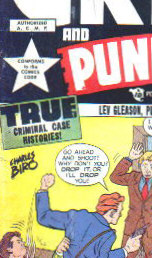 juveniles, shows the progress of a
boy addict and bears the legend: "The Comics Magazine Industry pledges itself to aid youngsters in their
fight against the enemies of youth - the dope peddlers." Are the children supposed to fight the adult drugracketeers?
That should be the concern of the adults. This page is in reality just an advertisement for "The
Comics Magazine Industry" and is highly misleading to parents and children alike. A typical comic book
with this page is one of the worst crime comics. Is this the proper setting for honest or effective advice to
juveniles, shows the progress of a
boy addict and bears the legend: "The Comics Magazine Industry pledges itself to aid youngsters in their
fight against the enemies of youth - the dope peddlers." Are the children supposed to fight the adult drugracketeers?
That should be the concern of the adults. This page is in reality just an advertisement for "The
Comics Magazine Industry" and is highly misleading to parents and children alike. A typical comic book
with this page is one of the worst crime comics. Is this the proper setting for honest or effective advice to
youth?
When adolescent drug addiction had finally come to public attention, it led to the publication of lurid new comic books devoted entirely to the subject, like the one with the title, Teen-Age Dope Slaves. This is nothing but another variety of crime comic of a particularly deplorable character.
A further adornment of crime comics may be a seal on the cover indicating that
the book is "Authorized A.C.M.P." (Association of Comics Magazine Publishers)
and "Conforms to the comics code." This association, which is not listed in the
telephone book, was formed following one of my most outspoken statements
about what parents don't know about comic books. A representative sample of a
comic book bearing this endorsement shows the customary unrelieved
succession of crimes and violence. And among the weapons advertised in this
comic book are guns, knives and whips - with thirty-seven illustrations of guns
altogether, one of them a high-powered air pistol at $19.95. A District Attorney
in New York City has definitely linked such arsenal advertisements to the actual
arsenals confiscated from juveniles by the police.
Two stories are characterized on their first pages as "true F.B.I. cases," two as
"true police cases." In one story, the first, out of fifty-one pictures no less than
forty-five are scenes of violence and brutality. This, according to the seal on the
cover, is an authorized percentage conforming to the comics code. I wonder how high the percentage must
run before a comic book is considered as not conforming to the code? In no book for adults, including
detective and mystery stories, in no movie, is such a proportion even approached.
The comic book I have just mentioned belonged to the early period of the much-publicized comics code.
One might expect that at that time the Association of Comics Magazine Publishers would have wanted to
do it particularly right, to show that the seal had a meaning. On the other hand, they may not have been
able to mend their ways so quickly, and the improvement might come about gradually.
So we carefully followed developments. In a crime comic that came out after the code had been in existence for some time, a representative specimen of this group shows: killing; a policeman knocked out with the usual smart contemptuous wisecrack: "I can't stick around to explain, copper!"; a man shot in the stomach; a woman mugged and then killed with a hammer to get her pocketbook; blood; the up-to-date ending of one murder story: "Archer Frize didn't die in the electric chair! The state psychiatrists found him to be insane!"; detailed instructions about how to hold up a big grocery store; and a brutal murder story with the murderer not caught by the law, but dying bv accident. (In the story murder is called a "mistake": "I knew it! They all make mistakes!")
The difficulty in arriving at accurate figures about comic books is considerable. One must distinguish between comic books printed, published, sold and, of course, read. The last item, the pass-on circulation, is most important, for many comic books after having been sold once for ten cents are not only traded for others, but are also sold repeatedly at lower prices: eight cents, six cents, two cents and even one cent. Even in such sales large sums are involved because the total numbers are so staggering. There are clandestine and half-clandestine stores, and backrooms of stores, about which adults know very little, which do business in these cut-rate transactions. On the whole crime comic books are monthly publications rather than bi-monthly like some of the harmless ones like Super Duck or Terrytoon Comics. They tend to have the largest editions and they are the ones most widely traded.
Owing to the conditioning of children by the industry, crime comic books are more widely read than
harmless comics. As the editor of one publishing house stated, "The sports line of comic books is the
cleanest type of comic book in America. We are going to drop it." (It was not 'lucrative.")
One crime comic book announces on its cover that it is read by six million readers. It is interesting that
this is one of the worst comic books, a veritable primer for teaching Junior juvenile delinquency. The
Minister of Justice of the Dominion of Canada called this particular book "a shocking instance of abuse of
freedom of the press."
At the time when the industry began to promulgate new codes - the first general one announced after my
first public criticism of crime comics - the number of crime comic books began to increase tremendously,
both absolutely and in relation to non-crime comics. From 1937 to 1947 only nineteen crime comic titles
existed, sixteen of them obvious crime comics, three of them so-called Western comic books that actually
featured crimes. But during 1948, 107 new titles of crime comic books appeared, 53 straight crime comics,
54 "Westerns" featuring crime.
It seems that the comic-book industry was in considerable conflict. On the one hand, they were not
anxious for the public to know that the comic-book business and its influence was so enormous - though
one publisher said in a revealing public statement, "When you get that big you just can't escape public
attention!" On the other hand, since a sizable amount of advertising is carried in comic books, they like to
use figures as large as possible. So while one could still find figures lower than my estimates, one could
also find figures as high as 75 million a month (Advertising Age) or 80 million a month (Association of
Comics Magazine Publishers).
The number of comic-book titles is a particularly elusive figure. As Advertising Age put it, "Statistics in
the comic book field are somewhat misleading. A certain amount of duplication and consequent
distortion..." are present. A number of times when I cited a specific comic book it disappeared - to
reappear promptly under a different name. Other titles just disappear, and new ones crop up constantly. So
do names of new publishing firms. That is why I have called crime comic books "hit and run
publications." Often the public does not even know which firm publishes which crime comic, because the
names of the firms publishing crime comic books are almost as elusive as the titles. They change, and
quite a number of concerns function under different names for different comic books. To count the
number of crime-comic titles at any given moment is therefore just as futile as to publish the names of
objectionable comic books.
Crime comic books represented about one tenth of the total of all comic books in 1946-1947. In 1948- 1949 they increased to one third of the total. By 1949 comic books featuring crime, violence and sadism made up over one half of the industry. By 1954 they form the vast majority of all comic books.
The problem of the effect of crime comic books is like a combined clinical and laboratory problem in
infectious diseases. You not only have to study the possibly affected individuals; you have to investigate
the potentially injurious agents themselves, their varieties, their lives, their habitat. There is a considerable
distance from the pure culture of the bacillus to the clinical case.
What about the "wholesome" adventure stories, the "Westerns," for example?
The vast majority, if not all Western comic books are crime comic books. They
describe all kinds of crime and brutality. For example, one marked on the cover
as "Your Favorite Western Star" has an "arsenal advertisement" on the inside
cover with the endorsement of ___ M.D., psychiatrist, on the page facing it. On
the back cover is a full-page advertisement with a gun pictured across the whole
page. This book is especially badly printed, and shows, among other things, the
close-up of a dying man with blood streaming from his mouth.
In another Western, one man has gold dust thrown in his eyes (an example of
what I call the injury- to- the- eye motif, this being a very frequent feature in
comic books).
Another comic book expresses the whole philosophy: "Since when do we worry about killin' people?"
Between its gory pages is a whole page devoted to an attack on "A Dr. Wertham [who] discussed the problem of juvenile delinquency in America today and pinned the blame for some of these cases on comic magazines." This page ends by drawing attention to "Dr. ___ 's [a psychiatrist] endorsement on the first page of every one of our magazines."
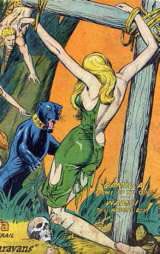 Jungle, horror and interplanetary comics are also crime comics of a special kind.
Jungle comics specialize in torture, bloodshed and lust in an exotic setting.
Jungle, horror and interplanetary comics are also crime comics of a special kind.
Jungle comics specialize in torture, bloodshed and lust in an exotic setting.
Daggers, claws, guns, wild animals, well- or over-developed girls in brassieres
and as little else as possible, dark "natives," fires, stakes, posts, chains, ropes,
big-chested and heavily muscled Nordic he-men dominate the stage. They
contain such details as one girl squirting fiery "radium dust" on the protruding
breasts of another girl ("I think I've discovered your Achilles' heel, chum!");
white men banging natives around; a close-up view of the branded breast of a
girl; a girl about to be blinded.
Whenever I see a book like this in the hands of a little seven- year- old boy, his
eyes glued to the printed page, I feel like a fool to have to prove that this kind
of thing is not good mental nourishment for children! What is wrong with the
prevailing ethics of educators and psychologists that they have silently
permitted this kind of thing year after year, and that after I had drawn attention to it some of them still
continued to defend it as helping children to learn about life and "get rid of their pent-up aggressions"?
However obvious it might seem, when I saw children getting into trouble and getting sent wholesale to
reformatories, I felt that I had to go on with this tedious work.
While the white people in jungle books are blonde and athletic and shapely, the idea conveyed about the
natives is that there are fleeting transitions between apes and humans. I have repeatedly found in my
studies that this characterization of colored peoples as subhuman, in conjunction with depiction of forceful
heroes as blond Nordic supermen, has made a deep - and I believe lasting - impression on young children.
And amidst all the violence between slaves, apes and humans in these books are big pictures of lush girls,
as nude as the Post Office permits. Even on an adult, the impression of sex plus violence is definite.
Quite apart from its sadistic groove, the imagination expressed in comic books is mechanical rather than in
any way creative. For instance, in a jungle book with the subtitle "The Jungle Girl," the "Satanic Dr.
Zanzere ... transplants a pair of bat's wings onto a tiger." The rest of this book is the usual parade of
invitation to sadistic perversion, race hatred and violence for violence's sake.
What about the "emotional release" a child is supposed to get according to the defenders of the comicbook industry? One story concludes with a close-up of a fist holding a gun and these words: "A gentle squeeze of the trigger and the last breath of life will be squeezed out of Nyoka! Read on for Part Three of The Treasure of the Tiger's Paw."
In the jungle books the jungle is not really a place but a state of mind. It is easily transposed into outer space in the interplanetary and science-fiction books. The girls are similarly dressed and similarly treated. Torture is more refined. If someone is to be blinded it is done with some extra-scientific instrument: "Now, ye Maid of Auro, reveal where the thorium has been hidden or my electric prong will burn the eyes from your pretty head."
The supermen are either half-undressed like their jungle brothers or dressed in fancy raiment that is a mixture of the costumes of S.S. men, divers and robots.
In one comic book of this group old-fashioned mugging - in recent years so frequently practiced by juveniles in large cities - is a recurrent theme, despite the interplanetary trappings. Blood flows freely, bosoms are half-bared, girls' buttocks are drawn with careful attention.
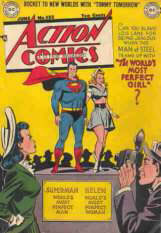 The Superman group of comic books is superendorsed. A random sample
shows on the inside cover the endorsement of two psychiatrists, one educator,
The Superman group of comic books is superendorsed. A random sample
shows on the inside cover the endorsement of two psychiatrists, one educator,
one English professor and a child-study consultant. On the page facing this
array is depicted a man dressed as a boy shooting a policeman in the mouth
(with a toy pistol). This is a prank - "Prankster's second childhood." In the story
there is a variant of the comic-book theme of a girl being thrown into the fire:"Her dress will be afire in one split second! She'll need Superman's help!"
In another story a tenement building is set afire - also to be taken care of by
Superman after it is afire. Until near the end of the book, attempts to kill people
are not looked upon askance, and are not to be prevented apparently by humans
but only by a superman. Then the lesson that after all you should not kill is
expressed like this: "You conniving unscrupulous cad! Try to murder Carol,
will you!" This is scarcely a moral condemnation. The lawyer who does not share in a million-dollar
swindle is praised by Superman because he "remained honest." In fact this honesty is rewarded with a
million dollars! A gun advertisement with four pictures of guns completes the impression that even if you
can't become Superman, at least you can rise above the average by using force.
This Superman-Batman-Wonder Woman group is a special form of crime comics. The gun advertisements are elaborate and realistic. In one story a foreign-looking scientist starts a green-shirt movement. Several boys told me that they thought he looked like Einstein. No person and no democratic agency can stop him. It requires the female superman, Wonder Woman. One picture shows the scientist addressing a public meeting: "So, my fellow Americans, it is time to give America back to Americans! Don't let foreigners take your jobs!" Member of the audience: "He's right!" Another, applauding: "YEAHHHH!"
The Superman type of comic books tends to force and super-force. Dr. Paul A. Witty, professor of education at Northwestern University, has well described these comics when he said that they "present our world in a kind of Fascist setting of violence and hate and destruction. I think it is bad for children," he goes on, "to get that kind of recurring diet ... [they] place too much emphasis on a Fascist society. Therefore the democratic ideals that we should seek are likely to be overlooked."
Actually, Superman (with the big S on his uniform - we should, I suppose, be thankful that it is not an S.S.)
needs an endless stream of ever new submen, criminals and "foreign- looking" people not only to justify
his existence but even to make it possible. It is this feature that engenders in children either one or the
other of two attitudes: either they fantasy themselves as supermen, with the attendant prejudices against
the submen, or it makes them submissive and receptive to the blandishments of strong men who will solve
all their social problems for them - by force.
Superman not only defies the laws of gravity, which his great strength makes conceivable; in addition he gives children a completely wrong idea of other basic physical laws. Not even Superman, for example, should be able to lift up a building while not standing on the ground, or to stop an airplane in mid air while flying himself.
Superwoman (Wonder Woman) is always a horror type. She is physically very
powerful, tortures men, has her own female following, is the cruel, "phallic"
woman. While she is a frightening figure for boys, she is an undesirable ideal
for girls, being the exact opposite of what girls are supposed to want to be.
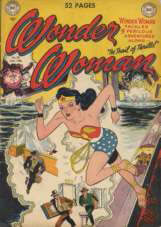 We have asked many children how they subdivide comic books. A thirteenyear-
old boy, in a letter to a national magazine commenting on one of Sterling
North's excellent articles on the subject, named five groups of harmful comics:
We have asked many children how they subdivide comic books. A thirteenyear-
old boy, in a letter to a national magazine commenting on one of Sterling
North's excellent articles on the subject, named five groups of harmful comics:
fantasy comics
crime comics
superman or superwoman comics
jungle comics (the worst, in my opinion)
comics which still pretend to be funny but throw in a lot of nudity to help them sell
Many children have a simpler classification. They distinguish between "jokey" books and "interesting
books." The latter they also call "exciting books" or "danger books." Very young children who supposedly
read only harmless animal comic books often see others in the hands of their older siblings or in other
places.
One Lafargue researcher asked a little six-year-old girl what comic books she liked and was told"corpsies." This baffled the researcher (that name would fit so many!). It finally developed when she produced the book that she meant "kewpies." It was one of the very few artistic comic books and had on its inside back cover a charming "Map of Kewpieville" showing Kewpie Square, Willow Wood, Mischief Grounds, Welcome Bridge, a Goblin Glen, Forsaken Lake, Blue Lake and a Snifflebrook. What was impressed on this child's mind, however, were the "corpsies" she had seen in the crime comic books of her friends.
Of course there are also super-animal magazines, like Super Duck. In one of them the duck yells: "No! I
kill the parents [of the rabbits]. I am a hard guy and my heart is made of stone!" The scene shows a rabbit
crying and begging for mercy, the duck poised to kill him with a baseball bat.
Just as there are wonder women there are wonder animals, like Wonder Ducks. In one such book there is a
full-page advertisement for guns, "throwing knives" and whips, and a two- page advertisement for"Official Marine Corps knives, used by the most rugged branch of the armed forces, leathernecks swear by
them."
There are also super-children, like Superboy. Superboy can slice a tree like a cake; can melt glass by
looking at it ("with his amazing X-ray eyes, Superboy proves the scientific law that focussed concentrated
X-rays can melt glass!"), defeats "a certain gang chief and his hirelings." Superboy rewrites American
history, too. In one story he helps George Washington's campaign and saves his life by hitting a Hessian
with a snowball. George Washington reports to the Continental Congress: "And sirs, this remarkable boy,
a Superboy, helped our boys win a great victory."
One third of a page of this book is a picture of Washington crossing the Delaware - with Superboy guiding
the boat through the ice floes. It is really Superboy who is crossing the Delaware, with George
Washington in the boat. All this travesty is endorsed by the impressive board of experts in psychiatry,
education and English literature.
Comic books adapted from classical literature are reportedly used in 25,000 schools in the United States.
If this is true, then I have never heard a more serious indictment of American education, for they
emasculate the classics, condense them (leaving out everything that makes the book great), are just as
badly printed and inartistically drawn as other comic books and, as I have often found, do not reveal to
children the world of good literature which has at all times been the mainstay of liberal and humanistic
education. They conceal it. The folklorist, G. Legman, writes of comic books based on classics, "After
being processed in this way, no classic, no matter who wrote it, is in any way distinguishable from the
floppity- rabbit and crime comics it is supposed to replace."
A writer of children's books, Eleanor Estes, has said of these [Classics
Illustrated] comics (in the Wilson Library Bulletin), "I think that worse than the
comic books that stick to their own fields are the ones that try to rehash the
classics. They really are pernicious, for it seems to me that they ruin for a child
the fine books which they are trying to popularize."
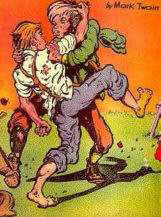 David Dempsey, writing in the New York Times Book Review, has said of the
comic book Julius Caesar that it has "a Brutus that looks astonishingly like
Superman. 'Our course will seem too bloody to cut the head off and then hack
the limbs...' says Brutus, in language that sounds like Captain Marvel..." and he
notes that "Julius Caesar is followed by a story called 'Tippy, the Terrier.'"
David Dempsey, writing in the New York Times Book Review, has said of the
comic book Julius Caesar that it has "a Brutus that looks astonishingly like
Superman. 'Our course will seem too bloody to cut the head off and then hack
the limbs...' says Brutus, in language that sounds like Captain Marvel..." and he
notes that "Julius Caesar is followed by a story called 'Tippy, the Terrier.'"
An adaptation from one of Mark Twain's novels has the picture of two small boys in a fight, one tearing the other's hair - a scene not the keynote of Mark
Twain's novel. Inside, three consecutive pictures show a fight between two
boys ("In an instant both boys were gripped together like cats")' and the last
picture shows one boy with a finger almost in the other's eye (the injury-to-theeye
motif again).
At the end of 1948 the 60 million comic books a month were split up between over four hundred comicbook titles of assorted types. All through 1948 the trend of the industry was toward crime comics.
Experts
of the industry were busy explaining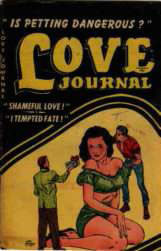 to credulous parents that the industry was only giving to children
what they needed and wanted, that scenes of crime and sadism were necessary for them, even good for
them, and that the industry was only supplying a demand. But in the meantime my advice to parents had
begun to take at least some hold. They had begun to look into crime comic books, and different groups
and local authorities started to contemplate, announce, attempt - and even to take - steps.
to credulous parents that the industry was only giving to children
what they needed and wanted, that scenes of crime and sadism were necessary for them, even good for
them, and that the industry was only supplying a demand. But in the meantime my advice to parents had
begun to take at least some hold. They had begun to look into crime comic books, and different groups
and local authorities started to contemplate, announce, attempt - and even to take - steps.
In direct response to all this [intense public scrutiny] the comics industry executed a brilliant and
successful maneuver. Leaving their psychiatric and child experts with their explanations and justifications,
they struck out on their own. The experts had said that what the children need is aggression, not affection -
crime, not love.
But suddenly the industry converted from blood to kisses. They tooled up the industry for a kind of comic book that hardly existed before, the love-confession type. They began to turn them out quickly and plentifully before their own experts had time to retool for the new production line and write scientific papers proving that what children really needed and wanted - what their psychological development really called for - was after all not murder, but love! In this new genre, shooting a girl in the stomach was out, though previously it had been so necessary.
There had of course been teen-age comics before. But they were mostly not about love or kissing, but in large part about humiliations, a disguised kind of psychological sadism. The confession type, on the other hand, implies a love relationship. There are misunderstandings, jealousies and triangle troubles. The girl is either too shy or too sociable, the boy friend is either the wrong one altogether or he says the wrong things. In many of them, in complete contrast to the previous teen-age group, sexual relations are assumed to have taken place in the background. Just as the crime-comics formula requires a violent ending, so the lovecomics formula demands that the story end with reconciliation.
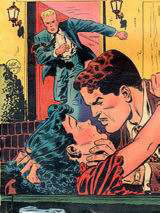 If we were to take seriously the experts of the comic-book industry, the
psychology of American children completely reversed itself in 1949. In order to
If we were to take seriously the experts of the comic-book industry, the
psychology of American children completely reversed itself in 1949. In order to
provide for the "deep psychological needs" of children, the industry had been
supplying more and more comic books about violence and crime. Now
suddenly it began producing dozens of new titles of love comics, to satisfy
children's new needs. Murder, Inc. became My Private Life; Western Killers
became My True Love. With the new and profitable policy of the industry, the
needs of children had changed overnight. All this would be funny if the
happiness and mental development of children were not involved.
Just as some crime comics are especially marked on the cover "For Adults Only" (which of course entices children even more), so some of the loveconfession comics are marked "Not Intended For Children." And just as there were supermen, superwomen, superboys and super-ducks, so the industry now supplied a "super-lover." Studying these love-confession books is even more tedious than studying the usual crime comic books. You have to wade through all the mushiness, the false sentiments, the social hypocrisy, the titillation, the cheapness.
Every investigation has its dark moments. One day I received a letter from a highly intelligent and socially active woman who had taken great interest in the curbing of crime comics. She wrote me that in her opinion the love and confession comics may be in bad taste, but at least they do no harm to children although they "give a false picture of love and life." This letter gave me the first doubt that I could ever achieve any practical results from my time-consuming investigation. What more harm can be done a child than to give him "a false picture of love and life"?
It is a mistake to think that love comics are read only by adolescent and older children. They are read by
very young children as well. An eight-year-old girl living in a very comfortable environment on Long
Island said, "I have lots of friends and we buy about one comic book a week and then we exchange. I can
read about ten a day. I like to read the comic hooks about love because when I go to sleep at night I love to
dream about love."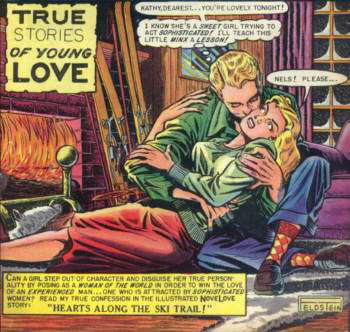
Another confession comic book is the reincarnation of a previous teen-age book with an innocuous title. That one was, despite its title, one of the most sexy, specializing in highly ccentuated and protruding breasts in practically every illustration. Adolescent boys call these headlight comics. This is a very successful way to stimulate a boy sexually. In other comic books, other secondary sexual characteristics of women, for example the hips, are played up in the drawing.
The confession comic into which this one turned has a totally different style, the new love- comics
formula. One story, "I Was a Spoiled Brat," begins with a big picture of an attractive girl looking at herself
in the mirror and baring herself considerably. The dash of violence here is supplied by a hit-and-run
driving accident and by the father's dying of a heart attack when he hears about his daughter's life. It all
comes out right in the last picture: "But I did live down my past. Tommy is now a leading merchant in
Grenville."
Flooding the market with love-confession comics was so successful in diverting attention from crime
comic books that it has been entirely overlooked that many of them really are crime comic books, with a
seasoning of love added. Unless the love comics are sprinkled with some crime they do not sell.
Apparently, love does not pay.
In one love comic a demonstration is given of how to steal a "very expensive gown, Paris original" from a
department store:
"I'll slip it on in the dressing-room. They won't notice me! I'll put it in that box and walk out, while the saleslady is busy with someone else! ... I walked out, trying to keep calm, trying to look and act natural ... Nobody has seen me! Ohh! If I can only reach the door!"
The youthful reader can also acquire the technique of how to seduce a girl. First
you get her boy friend away on a fictitious errand, "knowing it would keep him
for most of the night." After a dance you invite the girl for "a little bite" at "a
road house just over the state line":
NICKY: Here we are, Gale! A nice little private booth! Like it?
GALE: Yes' - (I wouldn't for the world let Nicky think I wasn't sophisticated
enough to appreciate it!)
Then you make love to her.
GALE: Nicky! Let me go! All these people!
NICKY: You're right, honey! What do we want all these people for? Let's go upstairs to the terrace!
"Upstairs was a long, narrow hall with five or six doors! Nicky opened the nearest one and I found myself
in a small, shoddy- looking room!"
NICKY: I think we'll be much more comfortable in here, don't you, honey?
GALE: Nicky! I want to go home! Please let me go!
NICKY: Home was never like this, baby! Come on, give papa a kiss!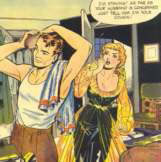
A nice friendly girl of twelve was brought to me by her mother because she had stolen some money from
a lodger. "She has a mind of her own," the mother said to me. "It goes and comes. The teacher complains
that she can't get any work out of her at times." Careful study of the girl over a period of time showed little
that was wrong. A social worker asked the mother how the girl spent her time after school. "Reading love
comics," the mother replied. "I have nothing against comic books, but she reads them all the time."
This girl I found to be an expert on love comics. She told me she bought some, "but mostly I trade them." I asked her about stealing in love comics. She laughed, "Oh, they do it often. A boy stole a bracelet from a girl he loves very much. He got caught but she still loved him. He spent a term in jail. When he got out he did it again and got sent up to jail again. The girl went to jail to see him, but she fell in love with another boy and got married." This girl was full of such plots. It was hard to determine whether she had daydreamed more of loving or of stealing.
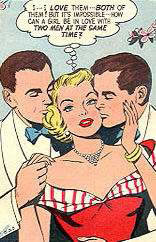 In the Daily Colonist (Victoria, B.C.) Arnie Myers reports on an interesting
study of love comics like Intimate Love, My Desire, My Love Life, Love
Scandals, Lovelorn and dozens of other similar titles. They are read mostly by"adolescent and pre-adolescent girls." The heroine invariably falls in love at first
sight "probably because of space limitations.... The books contain crime aplenty
In the Daily Colonist (Victoria, B.C.) Arnie Myers reports on an interesting
study of love comics like Intimate Love, My Desire, My Love Life, Love
Scandals, Lovelorn and dozens of other similar titles. They are read mostly by"adolescent and pre-adolescent girls." The heroine invariably falls in love at first
sight "probably because of space limitations.... The books contain crime aplenty
- murder suicide, abduction, arson, robbery, theft and various types of mayhem -
but crime is always subordinated to love.... The heroines indulge in vast
amounts of waywardness, infidelity, cheating, lying and assorted kinds of
trickery."
One national Parent-Teacher Association publication termed them "unsuitable for any age." Some newsdealers considered them "as bad as, or worse than, crime comics." One reported "a sale of thirty love comics to a sailor in his midtwenties." Whatever the mentality of this lonely sailor may have been, is this how we want to bring up eleven- or twelve-year-old girls nowadays?
During the time when the trend toward love-confession comics seemed to be in the ascendancy, those crime comics which continued without changing their policy were read more than ever. Toward the latter part of 1950 a reversal started. Having betrayed their experts by suddenly proclaiming that psychological need and popular demand was not for murder but for love and confession, the industry reversed itself again and set sail for sadism on the old and much-publicized theory that this is what children really need to get rid of their aggressions.
New crime comic books sprang up. Where formerly Murder Inc. had become My Private Life, and Western Killers had changed to My True Love, it was now the other way around. My Love Memoirs became Hunted, All Romances became My Risk, and My Intimate Affair became Inside Crime. Thus does an alert industry follow the abrupt changes in the psychology of American children. Or is it perhaps the other way around?
In one sample of this new psychotherapeutic aggression-removal, there are seventy-three scenes of
violence, corpses, wounded, murders and assault. In another a policeman who asks a criminal for his
driving license is shot outright. Recently I was asked to help in the defense of a youth who had committed
exactly this crime in Connecticut.
Many children read all varieties of crime comics and even poor children get hold of them in astonishingly
large numbers. A thirteen-year-old girl, in trouble for habitual truancy, said "I like jungle books. But I
read the others, too. My sister buys romance books, Diary of Real Life, True Romance, Sheena, Jo-Jo,
Jungle Jim - they are exciting! I like to see the way they jump up and kick men down and kill them! I like
Penalty, Crime Does Not Pay. I don't like them because the crook gets caught. I'd like him to get away
with it. They show how you steal. A woman walked in a store and took a dress and walked right out and a
woman caught her. I like to see women catch them. Sheena got a big jungle she lives in and people down
there likes her and would do anything for her. When I get ready go to bed I read them - about four comic
books. We don't all the time have enough to eat, because my mother hasn't got enough money to buy any."
In this case I saw a previous report by a psychologist which stated: "Marked sexual preoccupation
hampers her objectivity." It makes no mention of comic books - but it seems to me that they "hampered
her objectivity" most.
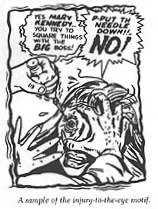
Frequently children remember only snatches from comics. A fifteen-year-old
girl, asked which comics she remembered, said, "I like one where a man puts a
needle in a woman's eye. The eye is all bloodshot and frightened. And another
one with a hunchback man carrying a woman from the grave or to the grave. I
read four or five a day." This is typical of how crime comics are reflected in a
child's mind. Nothing here of crime prevention or of ethical lessons.
Many children, when asked what comic books they like, answer simply like the
ten-year-old who reads ten a week, "I like murder comics."
One of the horror-type comic books for children is called Nightmare, A
Psychological Study. It is about a young man who mixes up nightmares with
reality and dies a horrible death, buried when the cement foundation of a building is poured over him. He
has received incompetent advice from a psychiatrist, Dr. Froyd, who, on his office door is called "Dr.
Fredric Froyd, psychiatrist." (Shades of Dr. Frederick Muttontop!)
The literary style of this "psychological study" shows the same predilection for non-language expletives
familiar in other comics. The psychiatric defenders of the comic-book industry maintain that this kind of
thing helps Junior with his emotional self-expression. And the educational defenders of the industry claim
it helps him with his literary expression. Another story, a "scientific Suspenstory" (sic!), illustrates how
many crime comic stories cannot be described as giving any "emotional release" because apart from their
other inadequacies they do not come to any end. The taste for violence is aroused - and maintained. The
story begins with "a hideous thing" and ends:
"The doctor is dead! But where is the THING? WHERE?? WHERE IS IT RIGHT NOW?"
Once in the waiting room of the Clinic I saw a little boy crouched over a comic book, oblivious to
everything around him. In passing I could see the title of the story he was reading. Big capitals spelled out
T A R Z A N. Surely, I thought, the adventures of Tarzan are harmless enough for juveniles of any age.
But I was misled, as many parents no doubt are. When I looked at this comic later I found on the inside
cover the picture of a man tied up in an agonizing position - a man "found dead in a Dallas park, his hands
tied behind him and two bullets in his worthless carcass"; another man shot in the back as he is thrown out
of a car ("Get out, ya stinking rat!") - and more of the same. Tarzan was not the whole title of the story I
had seen the boy in the waiting room reading. There was a subtitle "The Wyoming Killer" and two other
headings, "From Police Files" and "A True Crime Story." The story was not about Tarzan, but about a
hero who robbed a bank' and shot five men to death.
An excerpt from Seduction of the Innocent by Fredric Wertham (Rinehart & Company, Inc. New York, Toronto 1953, 1954)